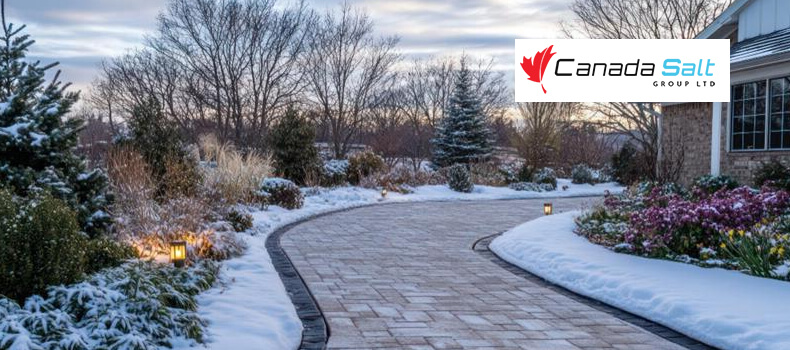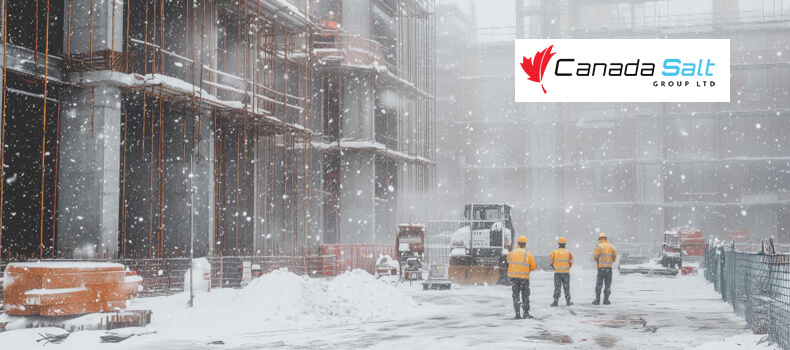Choosing Between Rock Salt and Treated Salt for Construction Zones
Construction sites are always busy and hazardous places, with machines, vehicles, and constant traffic and activity. During winter, these conditions become even more dangerous. Ice and snow formation make the ground more slippery, reducing traction, which is highly considered in construction sites. Therefore, selecting the right salt is crucial to maintaining a safe construction site, preventing delays, and protecting both workers and equipment. However, contractors and managers are confused about choosing between rock salt and treated salt for construction zones. In this article, we have detailed both options to help you make an informed decision. Let’s get started!
Understanding Rock Salt
What Is Rock Salt?
Rock salt is also called halite. It is one of the most affordable and widely used deicing materials worldwide. Rock salt is mined from underground salt deposits and then processed into coarse granules suitable for spreading on roads and other surfaces. The simple processing, natural availability and affordability made it a go-to option for winter safety.
Working with Rock Salt in Construction Sites
When rock salt is spread on the surface, it immediately begins lowering the freezing point of water. This process is called freezing point depression. Rock salt forms a brine between the surface and the ice layer, making snow removal easier. As construction sites will be busier with constant foot traffic and equipment movement, this quick action will ensure the area is safe for work.
Benefits of Rock Salt
Cost-effective
The major benefit of rock salt is its cost. When compared to other deicers, it is more affordable, making it an ideal solution for larger sites and companies operating on tight winter budgets. If your site includes wide areas, such as access roads, open spaces, or parking lots, rock salt is an affordable way to keep surfaces safe and clear during winter.
Easy Availability
Most of the bulk salt suppliers are ready with their rock salt piles. So, it is easier for you to find the salt even in the last minute. Therefore, it is beneficial for construction sites that need to respond quickly to sudden, unannounced weather changes.
Fast Application
When using rock salt as a deicer, no mixing, preparation, or special tools are required. You can apply it directly by using trucks, spreaders or shovels. This saves you a lot of time during sudden weather changes. Its ease of use also ensures that deicing will not affect any other work happening on the site.
Drawbacks of Rock Salt
Limited Performance in Extreme Cold
Even though rock salt is effective in a moderate climate, it gradually loses its effectiveness at temperatures below 15°F (-9°C). When the temperature is too low, rock salt struggles to form brine, making it unsuitable for regions with extreme winter climates.
Can Cause Surface Damage
Rock salt is corrosive in nature. So, it slowly damages infrastructure, such as metal surfaces, concrete, and tarnished tools, as well as vehicles and equipment present on construction job sites. Therefore, if you manage a construction company, you must consider this.
Environmental Concerns
Using more salt can cause it to seep into the soil and nearby water sources. As a result, chloride levels will increase, contaminating underground water and vegetation and disturbing the ecosystem. Generally, construction zones are located near sensitive land and water sources. So, keep this in mind and use salt wisely.
Understanding Treated Salt
What Is Treated Salt?
Treated salt is an enhanced version of rock salt that contains additives to improve its effectiveness. Common additives include calcium chloride, magnesium chloride, anti-caking agents or organic compounds. Combining salt with any of these additives or combinations can improve the overall effectiveness in winter.
How Treated Salt Works
Treated salt contains additives that facilitate rapid brine formation. Therefore, it causes the ice to melt faster, even at temperatures where regular rock salt loses its effectiveness. Most treated salts are effective even at temperatures as low as -20°F (-29°C), making them ideal for severe winter conditions. The treated coating on the salt helps it adhere to the surface better and reduces scattering.
Benefits of Treated Salt
Performs Better in Lower Temperatures
Treated salt has a higher melting point than rock salt, a valuable benefit for construction companies. When temperatures are low, instead of waiting, you can spread treated salt to ensure continuous worksite safety for workers, other equipment, and vehicles.
Reduced Bounce and Scatter
The coating on the treated salt helps it adhere to the surface rather than scatter or blow away. Therefore, product use will be controlled, resulting in better coverage and, in turn, saving time and reducing overall costs associated with frequent salt applications.
Environmentally Friendly
Compared to rock salt, a smaller amount of treated salt is required for deicing. There are also some organic and eco-friendly alternatives available that are more environmentally friendly. Therefore, this can lower chloride levels, thereby benefiting the ecosystem and promoting regulatory compliance.
Drawbacks of Treated Salt
Higher Cost
The cost will be higher than that of regular rock salt. The process involved in producing treated salt is extensive, which increases production costs. This may be concerning for construction sites operating on limited budgets.
Availability
Rock salt is more commonly found than treated salt. Only a limited number of suppliers offer it, and if you live in rural areas or warm regions, obtaining it in bulk can be challenging. So, plan it accordingly if your construction site relies on treated salt.
Key Differences Between Rock Salt and Treated Salt
Melting Performance
Rocksalt works effectively in a moderate winter climate. But treated salt works more effectively by melting ice faster, even at temperatures below -20°F (-29°C).
Cost Comparison
Rock salt is an affordable option, but we need frequent applications. Whereas treated salt is costlier but highly effective, it reduces labour and the need for frequent usage.
Safety Impact
Treated salt melts ice faster and provides better traction, reducing slips, equipment accidents, and other issues. This leads to safe working conditions, particularly in the construction zones with high foot traffic.
Environmental Impact
Using rock salt can impact soil and water quality due to its high chloride levels. So treated salt can be your go-to option if you are concerned about water and soil quality.
Application Effectiveness
Treated salt adheres to surfaces and works more effectively than rock salt. This also reduces waste and improves control in high-risk areas.
Factors to Consider When Choosing Salt for Construction Zones
Temperature Conditions
The choice of deicing salt depends on the temperature in your region. Areas with mild climates can use rock salt, whereas colder areas can use treated salt for better performance.
Budget Constraints
If your construction project operates on a limited budget, consider using rock salt instead of treated salt. However, remember that long-term efficiency is key to winter maintenance.
Environmental Regulations
Some regions have regulations that restrict the use of chloride. Therefore, construction sites in such regions must comply with environmental regulations and use eco-friendly alternatives, such as treated salt.
Traffic Volume and Safety Needs
Construction sites are the places where we observe frequent foot traffic and vehicle movement. So, you need a quick-acting deicing solution. Therefore, using treated salt can enhance safety, which is of utmost importance on construction sites.
When to Use Rock Salt
Ideal Situations
Rock salt is a great option for those living in regions with milder climates or places where it can be reapplied frequently. It also works well in areas where you need to cover a larger space and where environmental concerns are not a concern. If operating within a budget is the goal, choosing rock salt is a great choice.
Construction Site Examples
Rock salt is great for use on parking lots, staging areas, and temporary access roads where efficiency is not a concern.
When to Use Treated Salt
Ideal Situations
Treated salt is a smart choice for regions with extreme cold, heavy snowfall, and chloride-safety regulations. Projects that require strict environmental compliance or require rapid ice melting should opt for treated salt, as it offers the best results.
Construction Site Examples
Construction projects, such as highway construction, busy pedestrian routes, and bridge repairs, require treated salt for improved action and strong adherence. These projects entail high risks and require immediate ice-melting measures to ensure continuous, safer operations.
Tips for Effective Deicing in Construction Zones
Apply Salt Strategically
Analyze the job site to identify the most hazardous areas, such as sloped areas, entrances, walkways, and drop-off points, and prioritize them for salt application accordingly. This ensures that the risky zones are secured.
Monitor Temperatures
During winter, the weather can be unpredictable. Therefore, it is advisable to regularly monitor the temperature to determine whether to use rock salt or treated salt on that day.
Combine Salt with Other Winter Safety Practices
Using salt alone cannot handle winter hazards. So, combine deicing along with snow removal, sanding signs, worker training, and anti-slip materials. This ensures you have a complete winter safety plan.
Conclusion
Several factors should be considered when deciding between rock salt and treated salt. By understanding the factors and points mentioned above, construction managers can maintain safe, efficient, and productive operations regardless of winter conditions. Get ready for winter before it disrupts your work. At Canada Salt Group Ltd, we specialize in high-quality bulk road salt and treated salt, designed for faster melting and reliable performance, even in severe temperatures. Maintain your site safe and operational this winter! Contact us today to receive a complimentary quote.




